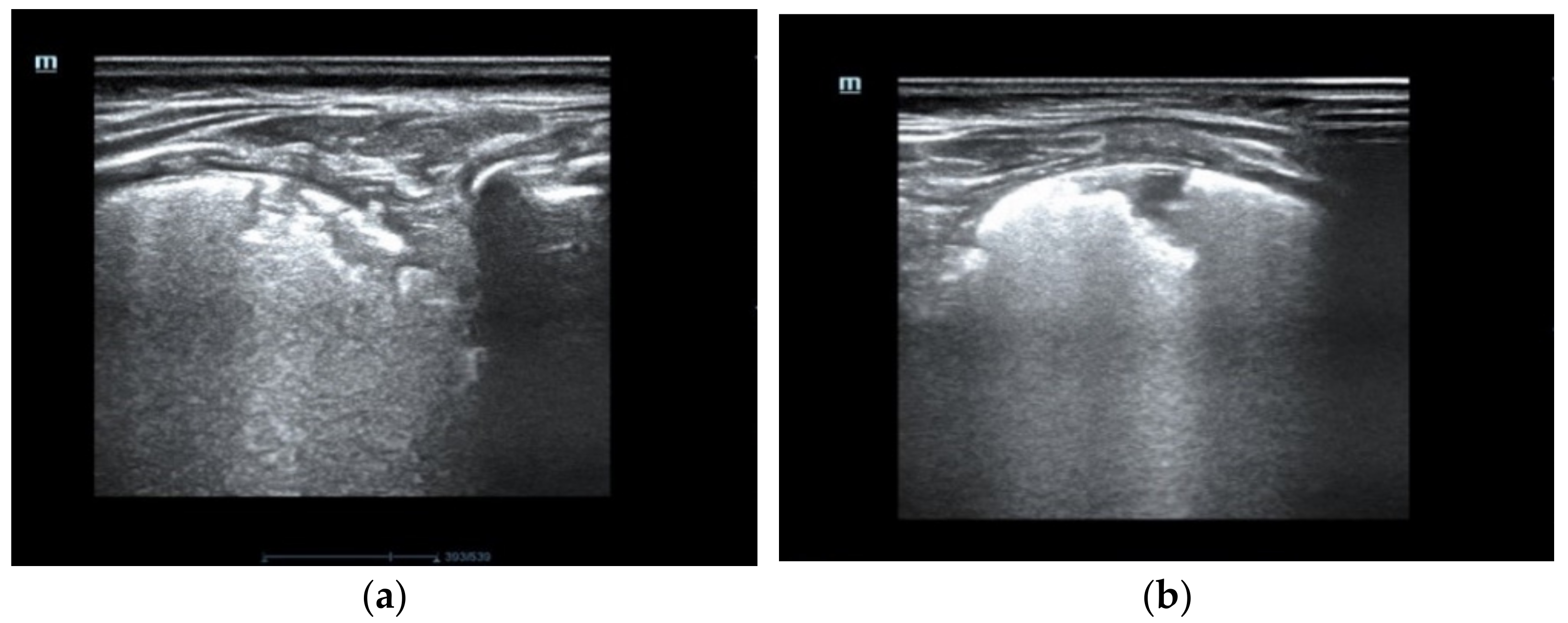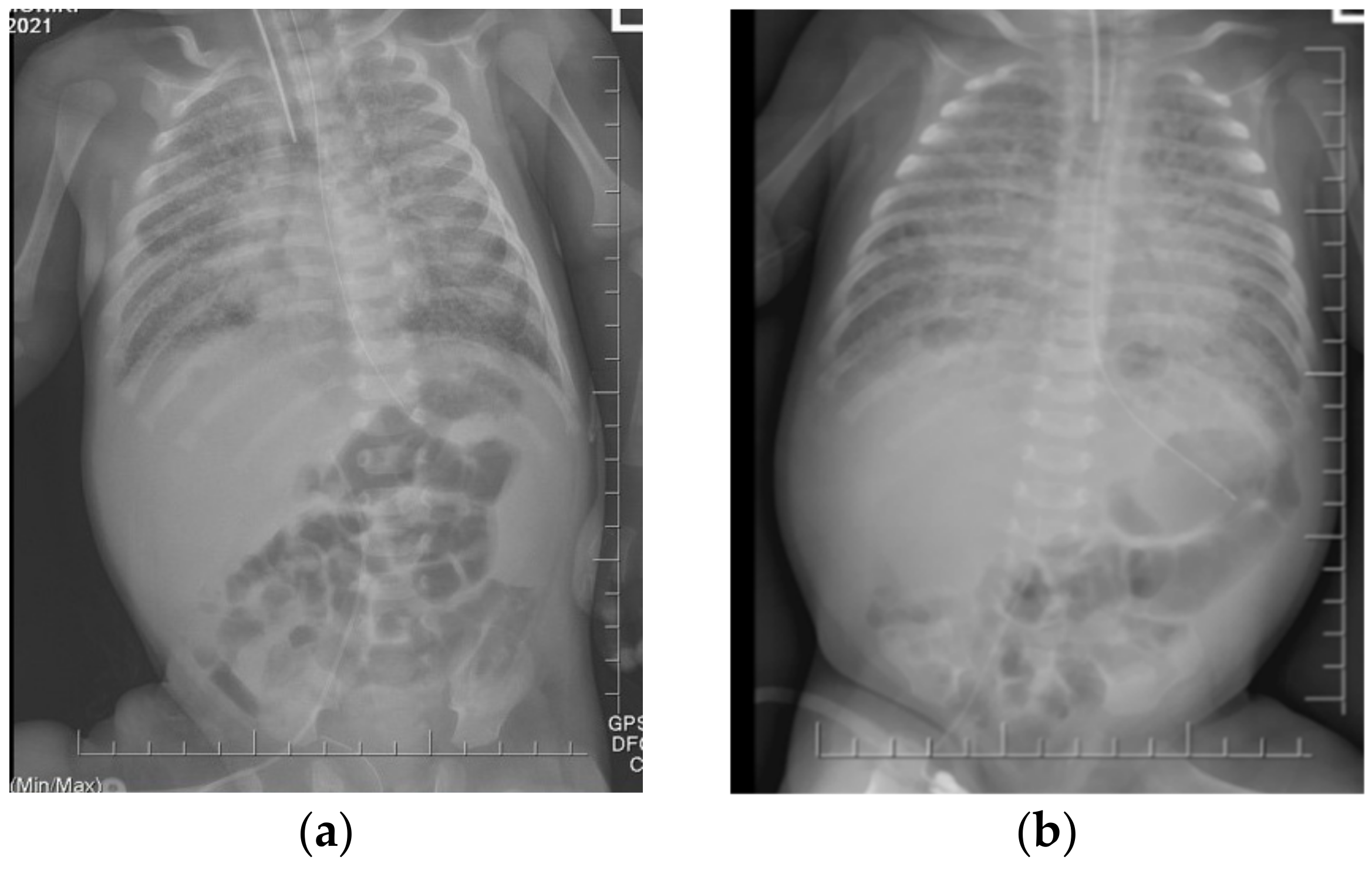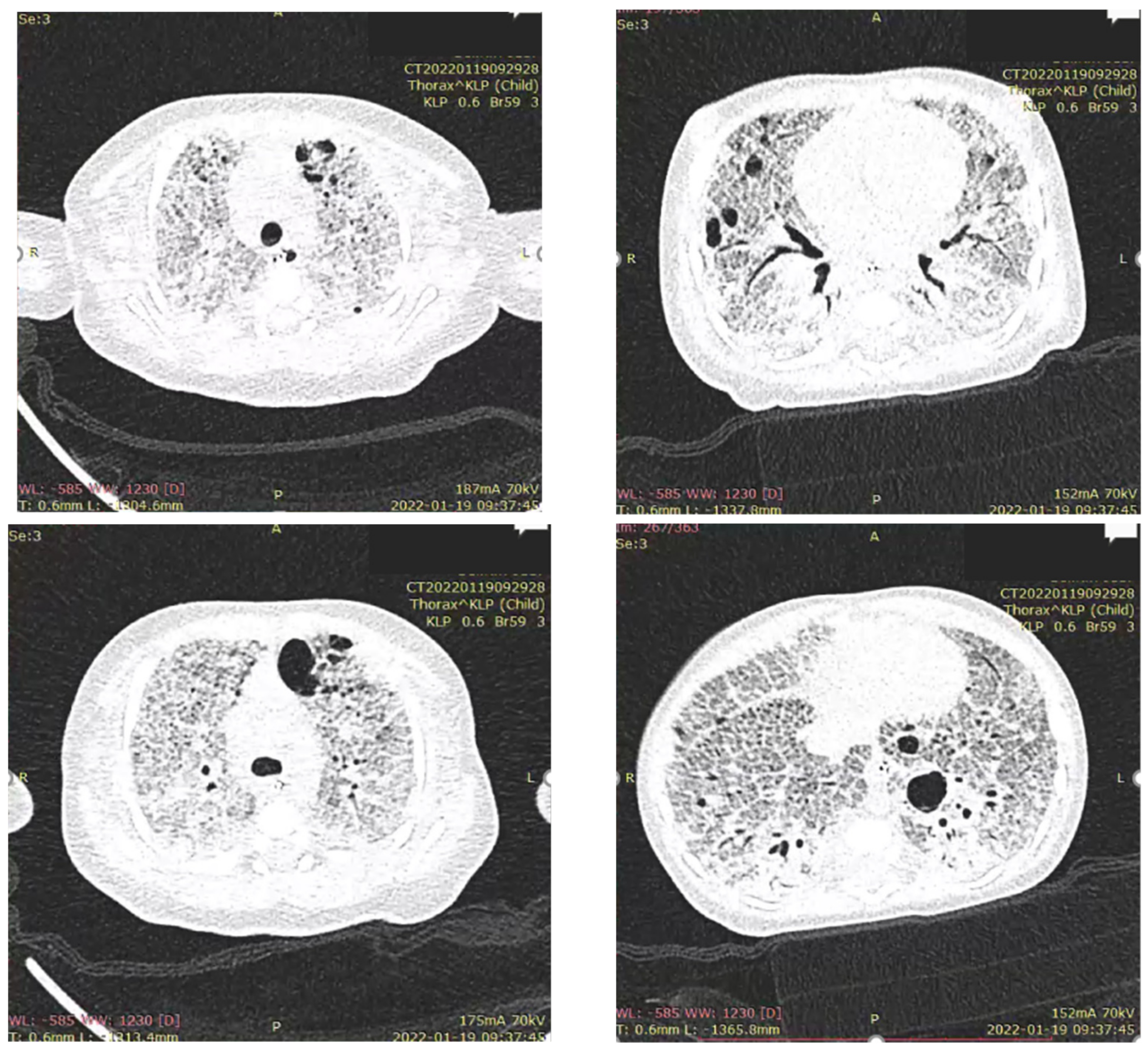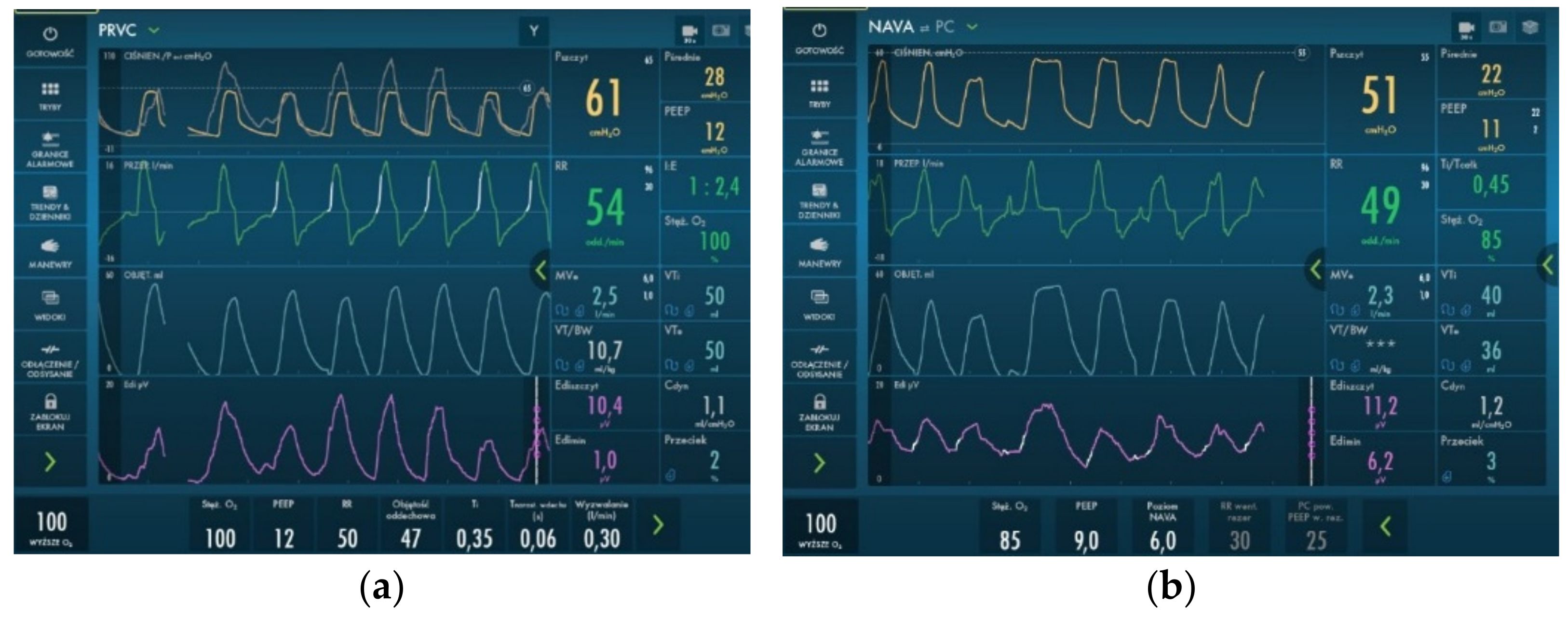Diagnostic Challenges in Neonatal Respiratory Distress—Congenital Surfactant Metabolism Dysfunction Caused by ABCA3 Mutation
Abstract
1. Introduction
2. Case Report
3. Discussion
4. Conclusions
Supplementary Materials
Author Contributions
Funding
Institutional Review Board Statement
Informed Consent Statement
Data Availability Statement
Conflicts of Interest
References
- Griese, M.; Haug, M.; Brasch, F.; Freihorst, A.; Lohse, P.; Von Kries, R.; Zimmermann, T.; Hartl, D. Incidence and classification of pediatric diffuse parenchymal lung diseases in Germany. Orphanet J. Rare Dis. 2009, 4, 26. [Google Scholar] [CrossRef] [PubMed]
- Malý, J.; Navrátilová, M.; Hornychová, H.; Looman, A.C. Respiratory failure in a term newborn due to compound heterozygous ABCA3 mutation: The case report of another lethal variant. J. Perinatol. 2014, 34, 951–953. [Google Scholar] [CrossRef] [PubMed]
- Mukhtar, G.M.A.; Al Otaibi, W.H.; Al-Mobaireek, K.F.A.; Al-Saleh, S. Adenosine triphosphate-binding cassette member A3 gene mutation in children from one family from Saudi Arabia. Ann. Thorac. Med. 2016, 11, 227–229. [Google Scholar] [CrossRef] [PubMed]
- Wambach, J.A.; Yang, P.; Wegner, D.J.; Heins, H.B.; Kaliberova, L.N.; Kaliberov, S.A.; Curiel, D.T.; White, F.V.; Hamvas, A.; Hackett, B.P.; et al. Functional Characterization of ATP-Binding Cassette Transporter A3 Mutations from Infants with Respiratory Distress Syndrome. Am. J. Respir. Cell Mol. Biol. 2016, 55, 716–721. [Google Scholar] [CrossRef] [PubMed]
- Gower, W.A.; Nogee, L.M. Surfactant Dysfunction. Paediatr. Respir. Rev. 2011, 12, 223–229. [Google Scholar] [CrossRef] [PubMed]
- Hallman, M. The Surfactant System Protects Both Fetus and Newborn. Neonatology 2013, 103, 320–326. [Google Scholar] [CrossRef] [PubMed]
- Wittmann, T.; Schindlbeck, U.; Höppner, S.; Kinting, S.; Frixel, S.; Kröner, C.; Liebisch, G.; Hegermann, J.; Aslanidis, C.; Brasch, F.; et al. Tools to explore ABCA3 mutations causing interstitial lung disease. Pediatr. Pulmonol. 2016, 51, 1284–1294. [Google Scholar] [CrossRef]
- Wambach, J.A.; Casey, A.M.; Fishman, M.P.; Wegner, D.J.; Wert, S.E.; Cole, F.S.; Hamvas, A.; Nogee, L.M. Genotype–Phenotype Correlations for Infants and Children with ABCA3 Deficiency. Am. J. Respir. Crit. Care Med. 2014, 189, 1538–1543. [Google Scholar] [CrossRef]
- Chowdhury, N.; Giles, B.L.; Dell, S.D. Full-Term Neonatal Respiratory Distress and Chronic Lung Disease. Pediatr. Ann. 2019, 48, e175–e181. [Google Scholar] [CrossRef]
- Bush, A.; Cunningham, S.; de Blic, J.; Barbato, A.; Clement, A.; Epaud, R.; Hengst, M.; Kiper, N.; Nicholson, A.G.; Wetzke, M.; et al. European protocols for the diagnosis and initial treatment of interstitial lung disease in children. Thorax 2015, 70, 1078–1084. [Google Scholar] [CrossRef]
- Flamein, F.; Riffault, L.; Muselet-Charlier, C.; Pernelle, J.; Feldmann, D.; Jonard, L.; Durand-Schneider, A.-M.; Coulomb, A.; Maurice, M.; Nogee, L.M.; et al. Molecular and cellular characteristics of ABCA3 mutations associated with diffuse parenchymal lung dis-eases in children. Hum. Mol. Genet. 2012, 21, 765–775. [Google Scholar] [CrossRef] [PubMed]
- Wambach, J.A.; Wegner, D.J.; DePass, K.; Heins, H.; Druley, T.E.; Mitra, R.D.; An, P.; Zhang, Q.; Nogee, L.M.; Cole, F.S.; et al. Single ABCA3 Mutations Increase Risk for Neonatal Respiratory Distress Syndrome. Pediatrics 2012, 130, e1575–e1582. [Google Scholar] [CrossRef] [PubMed]
- Cheong, N.; Zhang, H.; Madesh, M.; Zhao, M.; Yu, K.; Dodia, C.; Fisher, A.B.; Savani, R.C.; Shuman, H. ABCA3 Is Critical for Lamellar Body Biogenesis in Vivo. J. Biol. Chem. 2007, 282, 23811–23817. [Google Scholar] [CrossRef] [PubMed]
- Garmany, T.H.; Moxley, M.A.; White, F.V.; Dean, M.; Hull, W.M.; Whitsett, J.A.; Nogee, L.M.; Hamvas, A. Surfactant Composition and Function in Patients with ABCA3 Mutations. Pediatr. Res. 2006, 59, 801–805. [Google Scholar] [CrossRef] [PubMed]
- Hu, J.Y.; Yang, P.; Wegner, D.J.; Heins, H.B.; Luke, C.J.; Li, F.; White, F.V.; Silverman, G.A.; FCole, S.; Wambach, J.A. Functional Characterization of 4 ATP-Binding Cassette Transporter A3 Gene (ABCA3) Variants. Hum. Mutat. 2020, 41, 1298–1307. [Google Scholar] [CrossRef] [PubMed]
- Gonçalves, J.-P.; Pinheiro, L.; Costa, M.; Silva, A.; Gonçalves, A.; Pereira, A. Novel ABCA3 mutations as a cause of respiratory distress in a term newborn. Gene 2014, 534, 417–420. [Google Scholar] [CrossRef] [PubMed]
- Härtel, C.; Felderhoff-Müser, U.; Gebauer, C.; Hoehn, T.; Kribs, A.; Laux, R.; Möller, J.; Segerer, H.; Teig, N.; Von Der Wense, A.; et al. ATP-binding cassette member A3 (E292V) gene mutation and pulmonary morbidity in very-low-birth-weight infants. Acta Paediatr. 2011, 101, 380–383. [Google Scholar] [CrossRef]
- Garmany, T.H.; Wambach, J.A.; Heins, H.B.; Watkins-Torry, J.M.; Wegner, D.J.; Bennet, K.; An, P.; Land, G.; Saugstad, O.D.; Henderson, H.; et al. Population and disease-based prevalence of the common mutations associated with surfactant deficiency. Pediatr. Res. 2008, 63, 645–649. [Google Scholar] [CrossRef]
- Rezaei, F.; Shafiei, M.; Shariati, G.; Dehdashtian, A.; Mohebbi, M.; Galehdari, H. Novel Mutation in the ATP-Binding Cassette Transporter A3 (ABCA3) Encoding Gene Causes Respiratory Distress Syndrome in A Term Newborn in Southwest Iran. Iran. J. Pediatr. 2016, 26, 2493. [Google Scholar] [CrossRef]
- Wang, J.; Fan, J.; Zhang, Y.; Huang, L.; Shi, Y. ABCA3 gene mutations shape the clinical profiles of severe unexplained respiratory distress syndrome in late preterm and term infants. Transl. Pediatr. 2021, 10, 350–358. [Google Scholar] [CrossRef]
- Doan, M.L.; Guillerman, R.P.; Dishop, M.K.; Nogee, L.M.; Langston, C.; Mallory, G.B.; Sockrider, M.M.; Fan, L.L. Clinical, radiological and pathological features of ABCA3 mutations in children. Thorax 2008, 63, 366–373. [Google Scholar] [CrossRef] [PubMed]
- Szczapa, T.; Beck, J.; Migdal, M.; Gadzinowski, J. Monitoring diaphragm electrical activity and the detection of congenital central hypoventilation syndrome in a newborn. J. Perinatol. 2013, 33, 905–907. [Google Scholar] [CrossRef] [PubMed]
- Ciantelli, M.; Ghirri, P.; Presi, S.; Sigali, E.; Vuerich, M.; Somaschini, M.; Ferrari, M.; Boldrini, A.; Carrera, P. Fatal respiratory failure in a full-term newborn with two ABCA3 gene mutations: A case report. J. Perinatol. 2010, 31, 70–72. [Google Scholar] [CrossRef] [PubMed][Green Version]
- Nishida, D.; Kawabe, S.; Iwata, N.; Cho, K. ABCA3 deficiency dramatically improved by azithromycin administration. Pediatr. Int. 2021, 63, 602–604. [Google Scholar] [CrossRef]
- Kitazawa, H.; Moriya, K.; Niizuma, H.; Kawano, K.; Saito-Nanjo, Y.; Uchiyama, T.; Rikiishi, T.; Sasahara, Y.; Sakamoto, O.; Setoguchi, Y.; et al. Interstitial lung disease in two brothers with novel compound heterozygous ABCA3 mutations. Eur. J. Pediatr. 2013, 172, 953–957. [Google Scholar] [CrossRef]
- Williamson, M.; Wallis, C. Ten-year follow up of hydroxychloroquine treatment for ABCA3 deficiency. Pediatr. Pulmonol. 2014, 49, 299–301. [Google Scholar] [CrossRef] [PubMed]
- Kröner, C.; Wittmann, T.; Reu, S.; Teusch, V.; Klemme, M.; Rauch, D.; Hengst, M.; Kappler, M.; Cobanoglu, N.; Sismanlar, T.; et al. Lung disease caused by ABCA3 mutations. Thorax 2017, 72, 213–220. [Google Scholar] [CrossRef]
- Si, X.; Steffes, L.C.; Schymick, J.C.; Hazard, F.K.; Tracy, M.C.; Cornfield, D.N. Three Infants with Pathogenic Variants in the ABCA3 Gene: Presentation, Treatment, and Clinical Course. J. Pediatr. 2021, 231, 278–283. [Google Scholar] [CrossRef]
- López MD, C.; Ruiz, E.P.; Galdo, A.M.; Torrent-Vernetta, A.; Deu, M.; Ramirez, J.B.; Vives, M.A.R.; Aguilera, P.C.; Frías, F.J.P. ABCA3 Deficiency in a Newborn with Respiratory Failure. Arch. Bronconeumol. 2018, 54, 634–635. [Google Scholar]
- Eldridge, W.B.; Zhang, Q.; Faro, A.; Sweet, S.C.; Eghtesady, P.; Hamvas, A.; Co, F.S.; Wambac, J.A. Outcomes of Lung Transplantation for Infants and Children with Genetic Disorders of Surfactant Metabolism. J. Pediatr. 2017, 184, 157–164. [Google Scholar] [CrossRef]
- De Luca, D.; Tissieres, P.; Kneyber, M.C.J.; Humbert, M.; Mercier, O. Lung transplantation in neonates and infants: ESPNIC survey of European neonatologists and pediatric intensivists. Eur. J. Pediatr. 2021, 180, 295–298. [Google Scholar] [CrossRef] [PubMed]
- Griese, M. Chronic interstitial lung disease in children. Eur. Respir. Rev. 2018, 27, 170100. [Google Scholar] [CrossRef] [PubMed]
- Forstner, M.; Lin, S.; Yang, X.; Kinting, S.; Rothenaigner, I.; Schorpp, K.; Li, Y.; Hadian, K.; Griese, M. High-Content Screening Identifies Cyclosporin A as a Novel ABCA3-Specific Molecular Corrector. Am. J. Respir. Cell Mol. Biol. 2021, 66, 382–390. [Google Scholar] [CrossRef] [PubMed]
- Wambach, J.A.; Nogee, L.M.; Cole, F.S. First Steps Toward Personalized Therapies for ABCA3 Deficiency. Am. J. Respir. Cell Mol. Biol. 2022, 66, 349–350. [Google Scholar] [CrossRef] [PubMed]




Publisher’s Note: MDPI stays neutral with regard to jurisdictional claims in published maps and institutional affiliations. |
© 2022 by the authors. Licensee MDPI, Basel, Switzerland. This article is an open access article distributed under the terms and conditions of the Creative Commons Attribution (CC BY) license (https://creativecommons.org/licenses/by/4.0/).
Share and Cite
Rogulska, J.; Wróblewska-Seniuk, K.; Śmigiel, R.; Szydłowski, J.; Szczapa, T. Diagnostic Challenges in Neonatal Respiratory Distress—Congenital Surfactant Metabolism Dysfunction Caused by ABCA3 Mutation. Diagnostics 2022, 12, 1084. https://doi.org/10.3390/diagnostics12051084
Rogulska J, Wróblewska-Seniuk K, Śmigiel R, Szydłowski J, Szczapa T. Diagnostic Challenges in Neonatal Respiratory Distress—Congenital Surfactant Metabolism Dysfunction Caused by ABCA3 Mutation. Diagnostics. 2022; 12(5):1084. https://doi.org/10.3390/diagnostics12051084
Chicago/Turabian StyleRogulska, Justyna, Katarzyna Wróblewska-Seniuk, Robert Śmigiel, Jarosław Szydłowski, and Tomasz Szczapa. 2022. "Diagnostic Challenges in Neonatal Respiratory Distress—Congenital Surfactant Metabolism Dysfunction Caused by ABCA3 Mutation" Diagnostics 12, no. 5: 1084. https://doi.org/10.3390/diagnostics12051084
APA StyleRogulska, J., Wróblewska-Seniuk, K., Śmigiel, R., Szydłowski, J., & Szczapa, T. (2022). Diagnostic Challenges in Neonatal Respiratory Distress—Congenital Surfactant Metabolism Dysfunction Caused by ABCA3 Mutation. Diagnostics, 12(5), 1084. https://doi.org/10.3390/diagnostics12051084





